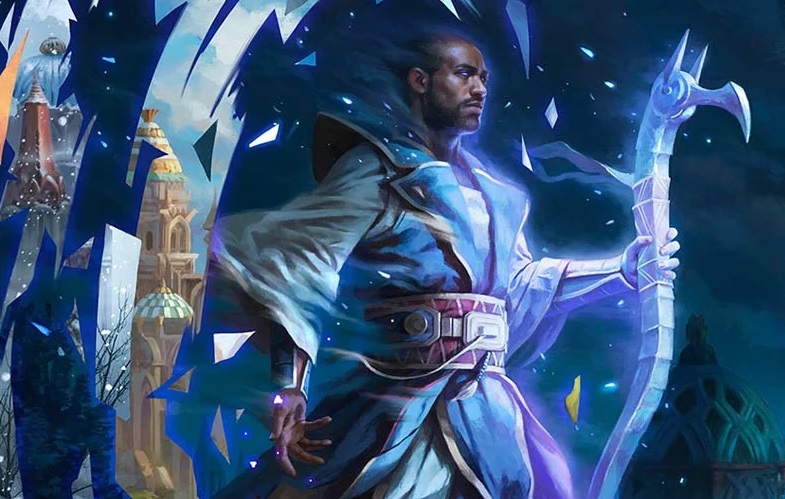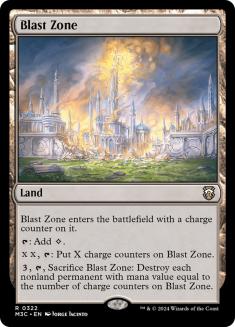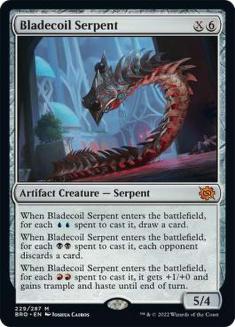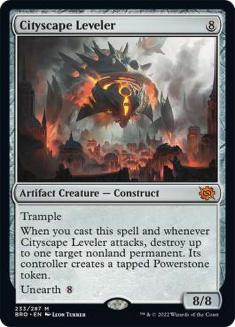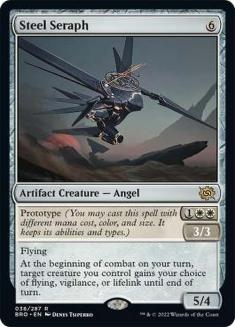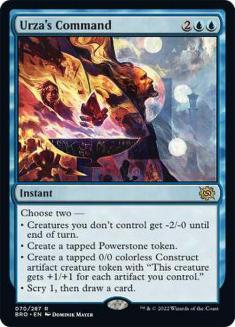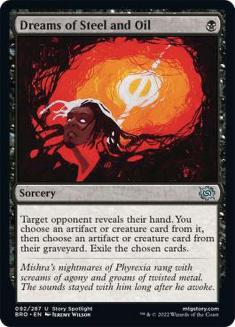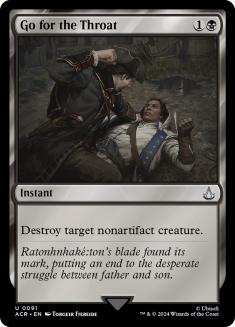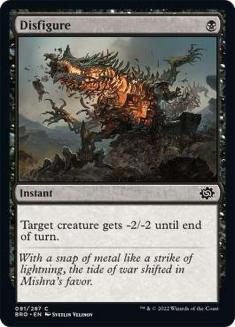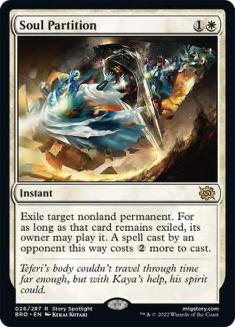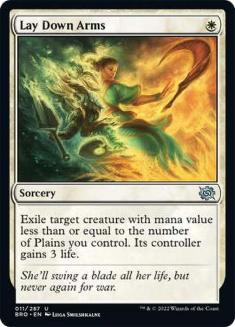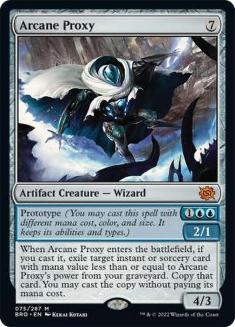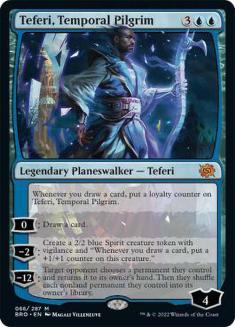I am more excited about The Brothers’ War than any Standard-legal set in the last couple of years. There is so much to work with for those of us who love control, especially in the traditional colors of that deck type. Esper is the true control shard, and many of us have been forced to incorporate red or green cards to remain competitive. Expressive Iteration was the main culprit this last year, with Simic dominance before that. Still, the purest form of control rests in blue, black, and white, for a variety of reasons.
Blue, White, Black
Blue is the staple control color. There have been instances where Mono-Black Control, or Orzhov Control, has been at the top of the metagame. Those are rare circumstances, and the reigns of those decks end very quickly. The card draw, disruption, and win conditions of blue have control written all over them throughout Magic’s existence.
With blue being necessary, the pairing has typically been between white and/or black. White and black are the removal colors that supplement blue to create the masterpieces that we have grown to love. I do not discriminate between Azorius, Dimir, and Esper Control, all of which have led me to significant successes. Esper Control has been my biggest claim to fame; however, the manabases of recent iterations have been difficult to justify. In addition to weak mana, the removal continues to get better with each passing year. The need to splash a third control color for better spot removal ended with the introduction of stronger white options. The same can be said for sweepers. White used to dominate that category, but black has had strong options in recent years.
When looking at a new set like The Brothers’ War, I spend most of my time dissecting the previews that fall into the Esper colors. I take a walk down the green and red aisle, but I am not really buying what they are selling. With this set, there are no shortage of playable control cards and some of those are likely to become staples in Standard. I had a difficult time drafting a Top 7 list for this set, so I cut a few corners to make it work. Lumping a few of the big hitters into categories helped make this an easier task, even though it still required some tough cuts.
#7: Blast Zone
Blast Zone is a very well-designed card that I am happy to have back in the format. With my two-color control options in Standard, there has been room for some colorless utility lands. Field of Ruin was the best to have around for the last couple of years; however, many of the threatening lands have left the format. The utility lands like Castle Vantress are gone, along with many of the creature-lands. It is finally safe to leave the deck development phase without Field of Ruin, opening a spot for another utility land.
Blast Zone enters the battlefield untapped and offers plenty of upside for control players. It is the answer to resolved permanents and is difficult to prevent. This land is one of the best-balanced out there, having a powerful ability, while being just slow enough for fairness. I am excited to include a couple of these in all my two-color Standard control decks moving forward.
#6: Big Old Artifact Creatures
I am a sucker for artifact-based control decks, likely where we are heading. In the meantime, these three creatures are strong on their own. Bladecoil Serpent and Cityscape Leveler will have the most impact on control decks in Standard, but I do like the design of Steel Seraph. Steel Seraph has evasion, can come down early, and has lifelink. For my veterans out there, you all know how underrated lifelink is on creatures. This could be a sideboard option for control decks, especially with any artifact synergy.
Bladecoil Serpent and Cityscape Leveler are fantastic creatures that can do real damage at the end of the curve. With the Powerstone mechanic, hitting large amounts of mana ahead of schedule is a realistic proposition. Even without it, Bladecoil Serpent can deal a devastating blow to the opponent if black mana is primarily used, while hooking up the control user if blue is used. I absolutely love the value tied into the creature and the X-bonus is the cherry on top. Without that last piece, the creature would still be phenomenal.
Cityscape Leveler will see a ton of play in Standard, and I hope the majority of it is from the control side. This monster destroys a nonland permanent on its cast trigger, making it a powerful addition to big mana decks. Its unearth ability is great, and the downside of providing tapped Powerstone tokens to the opponent is laughably low.
All these creatures are great and would be higher on my list, but they fall short based on their card type. Control is rarely struggling from the win condition side, with the majority of its stress coming from disruption and card draw.
#5: Urza’s Command
Urza’s Command is still a great card for control decks, though it has dropped some on my list. There are too many powerful disruption spells that leapfrog it from The Brothers’ War, but it will still be a staple in most of my future control decks in Standard. If artifacts are a big part of deckbuilding, then Urza’s Command is close to the top of the power rankings. As it stands, it is still a powerful utility spell that can provide value to any control deck. Producing a creature plus drawing a card after scrying is an exciting play that I can get behind in the upcoming Standard format.
#4: Dreams of Steel and Oil
This hand disruption spell is one of the most exciting prospects coming out of The Brothers’ War. Dreams of Steel and Oil seems like an ordinary Ostracize, but it is so much better. We are currently sitting with Duress, which is great in most formats. Outside of Standard, noncreature spells are typically the toughest for control to deal with, making Dovin’s Veto and Duress effects great. In Standard, I want to take out creatures, and Dreams of Steel and Oil does that very well.
In addition to creatures, Dreams of Steel and Oil hits artifacts. This is not the only upgrade that this hand disruption provides black-based control decks. Paying one black now allows you to take a creature or artifact from the opponent’s hand, choose one from their graveyard, and exile them. Exile has become one of the most sought-after effect for control players to harness. Many threats return from the graveyard, making this a premier hand disruption spell for the upcoming Standard format.
The strength of this card is high, without even the consideration of the beneficiaries like Lier, Disciple of the Drowned. I look forward to getting back in with black-based control and putting this card to work.
#3: The Removal Suite
The strength of removal from this set is through the roof. I was shocked to see Go for the Throat, before scrolling a bit more and seeing Disfigure. In the removal game, black is still dominating, but there are some white options for those still in that camp.
Soul Partition is a great card, one that can even be used defensively. I love the design of it and look forward to testing it out in Azorius and Esper Control as a one- or two-of. Lay Down Arms is more restrictive than its counterparts; however, it is a cheap removal spell that can take down big things. The same cannot be said for Disfigure, though it is an instant and requires less mana assistance to be effective.
I had a tough call between removal and the number two slot, because they are dependent on each other. Without the strong removal from this set, many of the other cards would be much weaker. Control depends on having the best removal and card draw to be successful, which it now has. Go for the Throat has highlighted the talents of the development team at Wizards of the Coast (WotC). It arrives in an artifact-heavy set but remains a staple removal spell in Standard. It is the card I am most excited about out of the removal list.
#2: Arcane Proxy
The top two spots have not shifted much for me over the last couple of weeks. Arcane Proxy, with all the removal in plain sight, has become one of the most powerful control cards that we have access to in Standard. It is amplified by the great removal and hand disruption that you see highlighted in this article, all of which you can re-cast the moment it arrives on Turn 3. The Snapcaster Mage feelings are back, and I am more amped about this interaction than any other.
Arcane Proxy will see the battlefield as a Prototype the vast majority of the time. Building a lean control deck is necessary these days, with all the disruption occurring on Turns 1 and 2. This is a change from the past, where the onus was on the Turn 4 sweeper to save us. With a cheaper curve, Arcane Proxy will fit seamlessly in the control gameplan of Standard. It is difficult to imagine playing something outside of Dimir Control with cards like this, but I will not count out an Esper possibility just yet.
#1: Teferi, Temporal Pilgrim
Teferi is back to haunt the enemies of control once again. While Teferi, Temporal Pilgrim may not be as good as Teferi, Time Raveler or Teferi, Hero of Dominaria, it is close enough. It is an immediate menace once it resolves, beginning the card advantage pile-on or protecting itself with threats that become humongous. Like Teferi, Hero of Dominaria, this planeswalker ends the game when left on the battlefield for a couple of turns. Its loyalty increases with each card drawn, adding yet another layer of torment to anyone that would dare try to remove it through combat.
It was again difficult to decide which card wins the number one slot, but Teferi, Temporal Pilgrim is something else. This is not your everyday dive-drop planeswalker. Each ability is a strong control effect, while having the static loyalty increase ticking away. That extra static item puts Teferi, Temporal Pilgrim over the edge and gives it the top spot. Arcane Proxy may see more Standard play overall; however, it is Teferi, Temporal Pilgrim that I look forward to playing the most.

